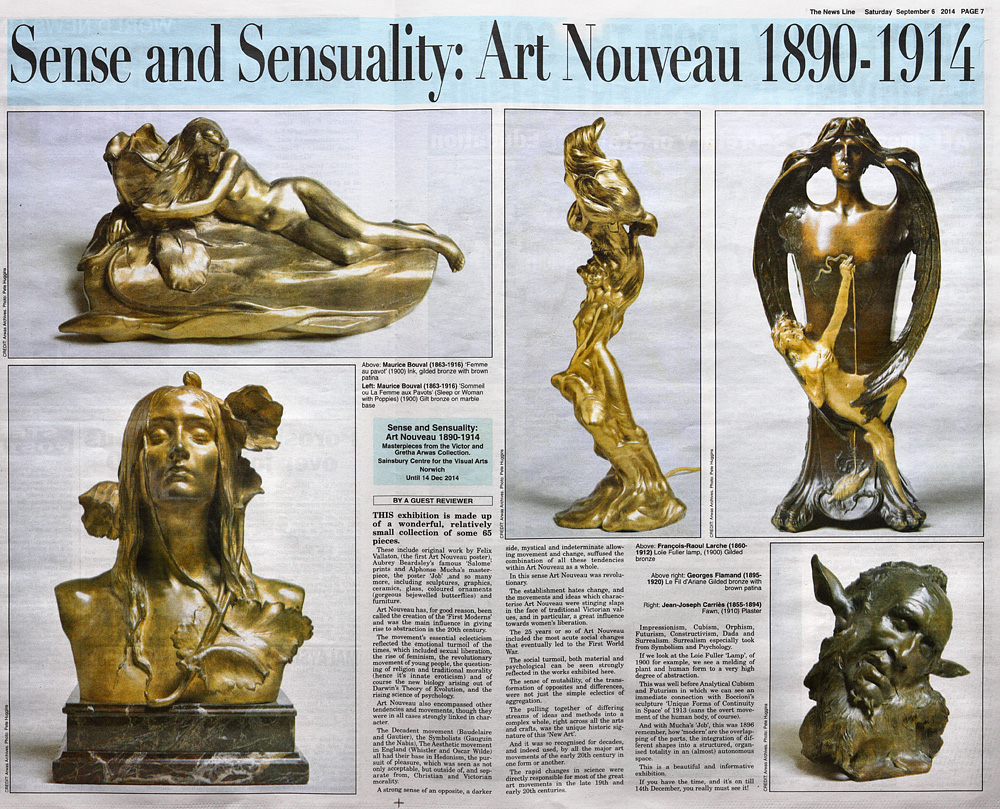
The News Line
Sense and Sensuality: Art Nouveau 1890 - 1914
Sense and Sensuality:
Art Nouveau 1890-1914
Masterpieces from the Victor and Gretha Arwas Collection.
Sainsbury Centre for the Visual Arts
Until
BY A GUEST REVIEWER
THIS exhibition is made up of a wonderful, relatively small collection of some 65 pieces. .
These include original work by Felix Vallaton, (the first Art Nouveau poster) Aubrey Beardsley's famous 'Salome: prints and Alphonse Mucha's masterpiece, the poster 'Job',and so many more, including sculptures, graphics, ceramics, glass, coloured ornaments (gorgeous bejewelled butterflies) and furniture.
Art Nouveau has, for good reason been called the creation of the 'First Moderns' and was the main influence in giving rise to abstraction in the 20th century.
The movement's
essential eclecticism reflected the emotional turmoil of the times,
which included sexual liberation the rise of feminism, the revolutionary
movement of young people, the questioning of religion and traditional
morality (hence it's innate eroticism) and of course :he new biology
arising out of
Art Nouveau also encompassed other tendencies and movements, though they were m all cases strongly linked in character.
The Decadent movement
(Baudelaire and Gautier), the Symbolists (Gauguin and the Nabis), The
Aesthetic movement in
A strong sense of an opposite, a darker side, mystical and indeterminate allowing movement and change, suffused the combination of all these tendencies within Art Nouveau as a whole.
In this sense Art Nouveau was revolutionary.
The establishment hates change, and the movements and ideas which characterise Art Nouveau were stinging slaps in the face of traditional Victorian values, and in particular, a great influence towards women's liberation.
The 25 years or so of Art Nouveau included the most acute social changes that eventually led to the First World War.
The social turmoil, both material and psychological can be seen strongly reflected in the works exhibited here.
The sense of mutability, of the transformation of opposites and differences, were not just the simple eclectics of aggregation.
The pulling together of differing streams of ideas and methods into a complex whole, right across all the arts and crafts, was the unique historic signature of this 'New Art'.
And it was so recognised for decades, and indeed used, by all the major art movements of the early 20th century in one form or another,
The rapid changes in science were directly responsible for most of the great art movements in the late 19th and early 20th centuries.
Impressionism, Cubism, Orphism, Futurism, Constructivism, Dada and Surrealism. Surrealism especially took from Symbolism and Psychology .
If we look at the Loie Fuller 'Lamp', of 1900 for example, we see a melding of plant and human form to a very high degree of abstraction.
This was well before Analytical Cubism and Futurism in which we can see an immediate connection with Boccioni's sculpture 'Unique Forms of Continuity in Space' of 1913 (sans the overt movement of the human body, of course).
And with Mucha's 'Job', this was 1896 remember, how 'modern' are the overlapping of the parts, the integration of different shapes into. a structured, organised totality in an (almost) autonomous space.
This is a beautiful and informative exhibition. .
If you have the time, and it's on till 14th December, you really must see it!